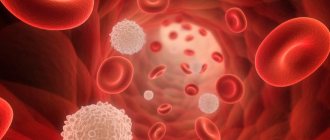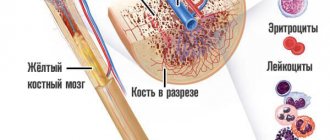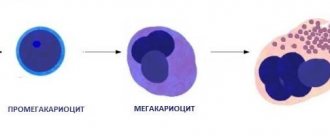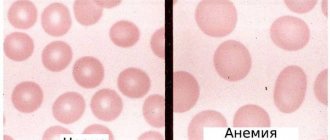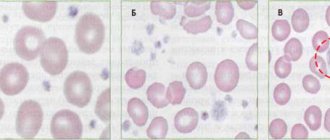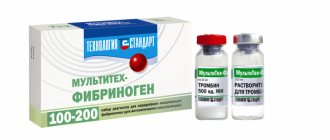MPV (short for mean platelet volume) is the designation of the platelet index, which characterizes the degree of platelet maturity in peripheral blood. The measurement is based on the fact that the size of young cells is larger than that of mature and aged cells. There is a connection between the size of platelets and their functional activity, so the index characterizes the state of the blood coagulation system, which platelets represent.
Determination of MPV in a general blood test is carried out within two hours after collecting the material, since with a later study the result may be distorted.
General blood analysis
A complete blood count (CBC, clinical blood test) is one of the most important and frequently prescribed laboratory tests. This analysis makes it possible to assess the condition of the body as a whole, confirm or exclude the suspected diagnosis, and monitor the progress of treatment.
Platelets are blood cells that stop bleeding if a blood vessel is damaged.
The first general blood test is performed for children in the maternity hospital. As the child grows up, it is recommended to carry it out regularly during routine medical examinations, which will make it possible to promptly identify abnormalities (for example, the development of iron deficiency anemia) and take the necessary measures in a timely manner. For preventive purposes, it is recommended to conduct a general blood test for adults once, and for children twice a year.
A general blood test includes determination of hemoglobin concentration, number of red blood cells, white blood cells and platelets, hematocrit level, as well as erythrocyte and platelet indices and erythrocyte sedimentation rate. A detailed blood test also includes a leukocyte count, which consists of determining the percentage of different types of leukocytes in the peripheral blood.
Counting the number of platelets and determining MPV is mandatory for women during pregnancy, as well as for patients with autoimmune diseases, varicose veins, liver pathologies, etc.
What to do if the MVP level is increased?
A thrombus, circulating with blood throughout the body, can enter a vessel of the heart or brain.
An increase in MVP production indicates that more cells are being produced than required.
Due to this, the consistency of the blood increases and the concentration becomes thicker. This disease is called thrombocytosis.
Thrombocytosis is dangerous because in excess blood clots begin to be created, which, reaching impressive sizes, can block the vessel and limit the blood supply.
Fatal outcomes are quite possible. Subsequently, it leads to heart attack and stroke, after which a third of sick people die.
Thrombocytosis is of two types:
- Relative – the norm is not significantly exceeded (from 20 to 30%)
- Critical - the norm is exceeded by 3-5 times.
In a critical case, urgent medical intervention is required!
An increase in MVP indicators is possible in two options:
- Certain physiological states of the body,
- Development of pathologies.
Physiological condition includes:
- Heavy menstrual bleeding
- Certain medications
- Features of the child's body,
- Various types of bleeding.
The development of such pathologies affects the increase in MVP:
- Injuries (mostly in large numbers),
- Surgical interventions
- Various types of bleeding.
The main reasons for increasing MVP are some diseases:
- Alcoholism,
- Atherosclerosis,
- Diabetes
- Deterioration of the thyroid gland,
- Blood cancer,
- and others.
A peculiarity in pregnant women is a frequent increase in platelets, which in the vast majority of cases is as it should be. Since the body of the expectant mother changes and adapts to more comfortable conditions for gestation. This can be explained by the fact that the fetus needs its own circulatory system. It is for this purpose that a woman’s circulatory system produces more platelets.
Platelets, their types and functions
Platelets (PLT, platelets) are blood cells with a diameter of 2-4 microns that provide blood clotting. The functions of platelets include angiotrophic (the ability to maintain the structure and functions of the walls of microvessels), adhesive-aggregation (formation of a primary platelet plug in damaged blood vessels), platelets are also involved in fibrinolysis, maintaining vasospasm, and blood clot retraction. These blood cells have the ability to transport circulating immune complexes on the membrane.
An increase in MPV may indicate the presence of thrombocytopenia, myeloproliferative diseases, posthemorrhagic anemia, hyperthyroidism, and diabetes mellitus.
There are five forms of platelets: young, mature, old, irritable and degenerative.
Platelets, like other blood cells, are produced in the bone marrow. Approximately two-thirds of the total number of platelets is in the bloodstream, and one-third is in the spleen. The precursors of platelets are megakaryocytes - giant cells with a large nucleus, from which platelets are released. Platelets are fragments of the cytoplasm of megakaryocytes surrounded by a membrane. They do not have a nucleus and their lifespan is approximately ten days. Platelet granules contain clotting factors, serotonin, calcium ions, adenosine diphosphate, peroxidase, platelet growth factor, von Willebrand factor, etc.
Platelets are round or oval in shape. When a blood vessel is damaged, they are activated, the cells flatten, form pseudopodia (long outgrowths) and acquire the ability to stick to other platelets (aggregation) and the walls of the damaged vessel (adhesion). A blood clot forms, which blocks the damaged area and thereby stops bleeding. Stimulators of platelet aggregation include serotonin, thrombin, collagen, and adrenaline. In a normal (inactive) state, the platelet membrane does not support coagulation reactions. There is a connection between the size of platelets and their functional activity, the content of biologically active substances in their granules, and their tendency to adhere.
Normally, the number of platelets in the blood is 180–320 × 109/l, varying depending on the time of year and time of day (daily fluctuations can reach 10%). A physiological increase in the number of platelets in the blood occurs when rising to altitude, in winter, after injury or exhausting physical activity. A physiological decrease in platelet count is observed before and during menstruation (up to 25–50%), as well as during pregnancy.
A significant decrease in MPV in the blood of a pregnant woman indicates a threat of miscarriage.
When the balance between the formation and destruction of platelets is disturbed, a tendency to thrombosis or increased bleeding occurs. With an increase in the number of platelets and the development of thrombosis, there is a risk of pulmonary embolism, stroke, myocardial infarction, and blockage of blood vessels in other organs by clots. A decrease in the number of platelets leads to hemorrhages and bleeding, which can also cause the development of life-threatening conditions.
The counting of platelets in the blood is carried out using an automatic hematological analyzer; in some cases, there is a need to determine the number of platelets and their sizes in stained blood smears under a microscope when calculating the leukocyte formula.
Platelet indices of a general blood test include:
- mean platelet volume (MPV);
- platelet distribution width by volume (PDW) – an indicator of platelet anisocytosis (depending on the predominance of young or old forms in the blood);
- thrombocrit (PCT) - indicates the proportion of blood volume occupied by platelets (depending on the total number of platelets and the MPV index).
Platelet indices allow you to assess the state of the blood coagulation system
Platelets are very sensitive
Blood platelets are very sensitive to changes in external conditions (atmospheric pressure, weather) and the state of the body, so their average volume can be increased or decreased not due to disease, but due to certain circumstances. This should not be forgotten when going to the laboratory. Therefore, you should not just drop in and donate blood, but prepare properly:
- Do not drink, eat or smoke in the morning;
- Avoid heavy physical work and mental stress the day before;
- Avoid taking various medications (you can take them after the test);
- If an R-graphy is prescribed on the day of testing, then it is better to reschedule it and do it later, and the same should be done with physiotherapeutic treatment.
In addition, it will be useful for patients to know that there are situations when MPV is lowered or increased by 1-2% of the upper or lower limit, but this is not a platelet pathology, evidence of a blood coagulation disorder, and does not indicate a failure of hematopoietic processes in the bone marrow.
For example:
- In children of the younger age group, MPV sometimes leaves the normal range due to the fact that the hematopoietic system has not yet completed its development;
- Deviations from the norm may be the result of surgical operations, injuries or acute blood loss;
- The average platelet volume may leave the normal range in women before and/or after menstruation.
All this can be explained simply: the body turns on compensatory mechanisms, active production of new blood platelets begins in the bone marrow, and young, large platelets appear in the bloodstream.
Preparation and delivery of a general blood test
To take a general blood test, standard preparation rules are used. Blood sampling is carried out in the morning on an empty stomach. On the eve of the study, you should avoid excessive physical and mental stress, and give up fatty foods. Before donating blood, you should not smoke; the patient should be completely at rest for half an hour before the test. Blood for general analysis can be taken either from a finger or from a vein.
Determination of MPV in a general blood test is carried out within two hours after collecting the material, since with a later study the result may be distorted.
A decrease in MPV may mean an enlarged spleen (splenomegaly), the presence of liver cirrhosis, hypoproteinemia, kidney disease, and thyroid pathologies.
Additional examinations
A blood test gives an approximate idea of the state of the body. It only allows us to state a fact: there is a problem. Why it arose is a different question, and the answer to it is sought using auxiliary techniques.
The examination is carried out by a hematologist. Third party specialists are brought in as needed.
- Oral interview with the patient. Complaints are informative in some cases. Symptoms indicate damage to one or another organ.
- Anamnesis collection. Lifestyle, past and current diseases, family history, genetics and other points. The doctor collects them for interpretation and determines the possible source of the problem. Its origins.
- Ultrasound of the digestive tract. First of all, specialists are interested in the liver.
- To study the functional state of the largest gland in the body, scintigraphy is prescribed. Radioisotope technique.
- A blood test for hormones helps identify thyroid diseases.
- Specific, extreme measures are possible. Bone marrow puncture, histological evaluation of the obtained material.
- If necessary, diabetes is diagnosed with special tests: sugar curve and others.
The question of examination is within the competence of the doctor. The list can be expanded or narrowed. Of necessity.
MPV in a blood test: decoding, norms in women and men
Determination of MPV is important for assessing the hematopoietic function of the body. Using the MPV platelet index in a blood test, you can detect increased platelet aggregation, thrombosis, and active blood loss (if large platelets are detected in people with iron deficiency anemia). In addition, the MPV indicator in a blood test acts as an additional marker of chronic myeloproliferative diseases (the presence of large platelets in the peripheral blood).
The normal MPV in adults is the same for women and men and is 6–13 fl. In children under one year old, the MPV norm is 7–7.9 fl, 1–5 years old – 8–8.8 fl. For children over 5 years of age, the normal values are the same as for adults.
An elevated MPV platelet index indicates the presence of large platelets in the patient's peripheral blood. If the MPV in the blood test is low, this means a predominance of small platelets.
Average platelet volume is reduced
Platelets are elements of the blood that play an important role in clotting. Under certain pathological conditions, the average volume may decrease. To accurately determine the cause of the decrease in volume, a detailed examination must be carried out.
Formation of a primary plug and stopping bleeding
Normal indicators
The following values are considered normal values for the total platelet count:
- adult men and women - 150-400x109 cells/l;
- women during menstruation - 75-220x109 cells/l;
- children - 100-480x109kl/l.
Indicators may vary depending on the individual characteristics of the person. During pregnancy, your platelet cell count may fall. It is recommended to undergo analysis periodically in order to know your personal norm and, if necessary, detect deviations from the usual values.
Normal average volume is 7-10 Fl. In men, the average volume is slightly more than 10-11 Fl. The indicator is reflected in the general analysis. Based on the results of the study, the state of human health is judged.
More details about platelets, their number and average in the video:
When MPV in a blood test is increased and decreased
An increase in MPV may indicate the presence of thrombocytopenia, myeloproliferative diseases, posthemorrhagic anemia, hyperthyroidism, diabetes mellitus, infectious and inflammatory diseases, neoplasms, preeclampsia, idiopathic thrombocytopenic purpura, impaired platelet formation due to a lack of vitamin B12 or folic acid in the body, May-Hegglin anomaly , Bernard–Soulier syndrome. The index also increases after surgical removal of the spleen (splenectomy), in smoking patients with atherosclerotic changes in blood vessels, with alcoholism and taking certain medications, and in the elderly.
When the balance between the formation and destruction of platelets is disturbed, a tendency to thrombosis or increased bleeding occurs.
Causes
It is difficult to determine what influenced the increase in platelets in the blood. To determine the causes in a woman or man, the doctor needs to evaluate the results of a comprehensive examination of the body. He will also need to assess your current condition and the presence of chronic diseases that may cause your platelets to be elevated.
Type of blood clot
An increase in the level of these elements in the blood can be provoked by:
- Diseases of the circulatory system;
- Exacerbations of chronic ailments;
- Inflammatory processes in the body;
- The presence of a virus infection in the blood;
- Consequences of surgical interventions;
- Taking certain medications;
- The influence of colds and flu.
What does a decrease in MPV mean?
A decrease in MPV may mean an enlarged spleen (splenomegaly), the presence of liver cirrhosis, hypoproteinemia, kidney disease, and thyroid pathologies. The platelet index decreases in aplastic anemia, septic thrombocytopenia, congenital megakaryocytic hypoplasia, Wiskott-Aldrich syndrome, X-linked thrombocytopenia with platelet microcytosis, thrombocytopenia caused by immunological destruction of cells, as well as during chemotherapy and during pregnancy. A significant decrease in MPV in the blood of a pregnant woman indicates a threat of miscarriage.
